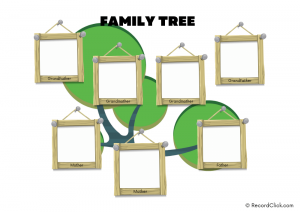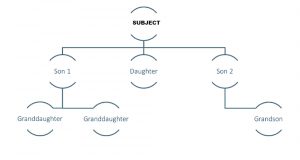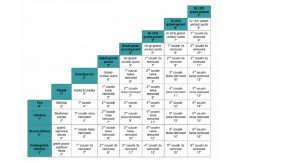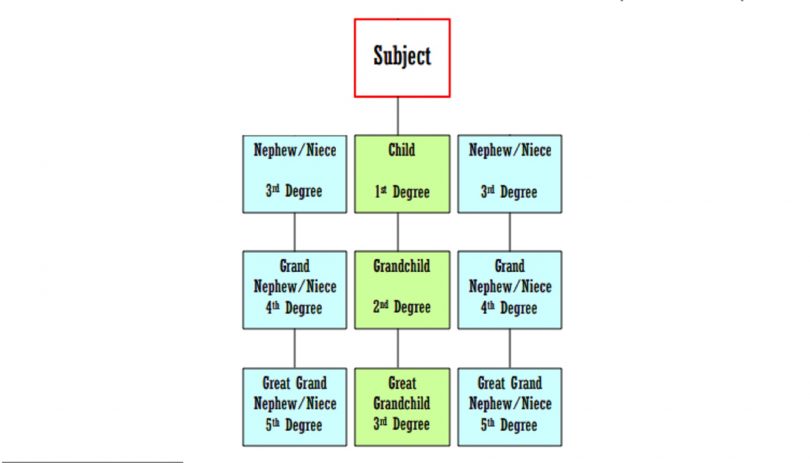Table of Contents
A lineal descendants chart details the blood relatives in the direct line of descent – the children, grandchildren, great-grandchildren, etc. of a person.
Having a detailed analysis of these descendants is crucial especially when someone dies intestate (without a valid will).
One of the many things that happen when someone dies intestate is the heir search. The administrator or executor establishes the estate left by the decedent and all the beneficiaries.
After appointing an estate administrator, the probate court requires them to follow applicable laws and identify unknown or missing heirs. Usually, the estate distribution prioritizes the spouse and the children, hence the need to create and complete a lineal descendant chart.
Key Takeaways
- Lineal descendants include your children, grandchildren, and so on.
- A lineal descendant chart illustrates the generations originating from a single person or couple.
- A lineal descendent chart is crucial when presenting evidence of your kinship to a testator.
Who Are Lineal Descendants?

family tree frame
Also known as an issue, lineal descendants are the generations from a common ancestor. They include children, grandchildren, and so on. Lineal descendants are crucial in intestate succession as the probate court and intestacy laws prioritize them during estate distribution.
Note that the law has no variance between adopted and biological descendants, and both enjoy equal rights. However, your biological children may not count in intestacy cases if they are legally adopted elsewhere.
Simply put, lineal descendants are the opposite of lineal ascendants, comprising the parents, grandparents, etc. Other forms of descendants are the collateral descendants, who are the lineal descendants of a sibling. They comprise cousins, aunts, nephews, aunts, and nieces.
What is a Lineal Descendants Chart?

Lineal Descendants Chart
As the name suggests, a lineal descendant chart illustrates the generations originating from a single person or couple. Normally, the person or couple is at the top of the chart, and their children, grandchildren, and great-grandparents follow. This chart plays a significant role in keeping track of your offspring and helps them know the connection with their other relatives such as cousins.
A lineal descendants chart must include spouses for all the individuals, and the width depends on the number of individuals in each generational level and their marital status. For this reason, families with many children and descendants require an extensive chart to accommodate all and indicate personal details.
In this chart, apart from spouses and adopted, every person shares some part of their DNA from the person at the top. Also, the chart does not include siblings or parents for the person at the top.
Genealogical Numbering in A Lineal Descendants Chart

Table of Consanguinity
Genealogical numbering is a critical part of heir search and family tree publications. Every individual on a chart has a number that determines their degree of relation to the common ancestor. While you’re likely to encounter different numbering methods, all the systems serve a common purpose: to keep things organized and help you quickly identify relationships on a chart.
Lineal descendant charts use the Register Numbering System that most Historical and Genealogy Societies use for publications. This system only numbers the blood-line descendants and not their spouses.
The common ancestor at the top of the chart is given the number 1. In contrast, the children are given a lowercase Roman numeral in their birth order. This way, every descendant has a unique number.
Numbering in Other Charts
Unlike lineal descendants charts, ancestry charts start with the child, and the ancestors branch out in generations. The ancestry formation uses the Ahnentafel numbering system with the child as number 1, the father as 2, the mother as 3, and so on.
Numbering in family tree charts helps keep track of family members and makes the whole thing simple.
Benefits of a Lineal Descendant Chart

Heir search must follow the law
A lineal descendent chart is crucial when you want to present evidence of your relation to a testator. Therefore, having one already created or consulting a professional genealogist to create one is vital to ensure you’re included when an administrator distributes the estate to valid beneficiaries. Below are other benefits that you may reap from a descendants chart.
- Understand Your Heritage
Completing a descendants chart is an exciting journey that helps you not only detail heirship but also create an understanding of your heritage. Descendants will know where they came from and how they settled in their local communities.
- Detailing Family Members on a Visual Depiction
One real advantage of a lineal descendant chart is exploring descendants and discovering unknown or missing relatives. This way, you can tell who should be prioritized regarding heirship and how to explain the genealogy to a probate judge.
- Fun
Completing a descendant chart is fun as you spend your leisure time making enjoyable discoveries and depicting how you originated from a common ancestor. The task may be daunting, especially for complex family structures, but we have tricks to untangle mysteries.
Where Can I Find a Lineal Descendant Chart?
If you need a lineal descendant chart completed ASAP, we can do that and send a PDF preview your way. You only need to let us know the proper dimensions and design, and we can proceed with drafting and printing.
In addition, we have descendant charts and other family tree templates on our site ready for editing and download. So, please review the available templates as you read the guides on each design.
You’ll surely love our genealogy services that confidently provide a money-back guarantee. Feel free to contact us if you need clarification or guidance on heir search or completing any chart.







